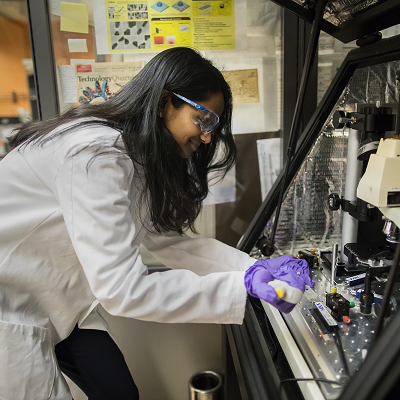
2021-01-21
Visited : 1787
Single atomic-scale pores containing engineered materials, developed by researchers of Pennsylvania University, has paved the way for more realistic measurements in angstrom-size dimension leading to various applications such as filtration.
According to the imperative affection of materials atomic building units design and construction on their properties and traits, new single-atomic scale scientific investigations focusing on porous structures have brought about notable material features and consequent applications.
In Drndic's lab, a group has been working for one year developing techniques and characterize obtained materials to expand the discussing project in scientific grades.
In more details, Thiruraman and Masih Das fabricated zero-dimensional pores in monolayer MoS2 with the possible usage of ionic transferring (resulting paper is published in ACS Nano journal) to be composed of a few atoms missing in the two-dimensional (2D) lattice (1–5 Mo atoms).
In line with the above-mentioned running project, named researchers in collaboration with Manchester University and conducted with Shahid Rajaee University and Antwerp University, applied focused ion beam irradiation method to generate a sort of gas filtration apparatus investigating helium atomic gas flow through atomic vacancies from missing tungsten (W) sites in pristine monolayer tungsten disulfide (WS2) membranes which act as atomically thin barriers for helium gas atoms transmission (relevant article broadcasted in Science Advanced journal).
To scrutinize challenges and achievement of created angstrom-size pores, it has been indicated that engineering materials containing nano-pores with the width of 100000 times smaller than human hair width and actually suitable for single atoms and small molecule passage appear practicable but uncontrollable physically to be a functional membrane in use.
In another approach, Thiruraman and Masih Das made an effort in the way of a flexible single atomic-size porous structure done by general modification of the formerly used method. Considered modification led to the utilization of the chemical vapor deposition (CVD) process to form a single atom layer of the chosen material and got a punch on the surface by TEM beam to contain angstrom-scale pores.
Performed systematic adjustments made the scientific attainment aspects more measurable (i.e., measuring atoms passing through holes), experimentally possible, and precise which means to have an actual working device in comparison to dominant theoretical researches done in single atomic-scale science.
As an example, mentioned published article in ACS Nano journal reports on salt ion elimination from non-selective saltwater. The other encountered issues can be enumerated as the unknown status of pore size stability and probable changes in material transport mechanisms and device properties.
Discussed apparatus conceivable applications are analyzed to be water desalination and purification, gas filtration, creating pores mimicking ion channel in biological approaches, energy harvesting, measuring small molecules such as hormones, pharmaceuticals and to name but a few.
Statnano has arranged for a new controversial survey questioning the most impressive nano-scale event of 2020. Therefore, given topic can bright up one of the collected events feature to you and help the participation process in the following related survey link: